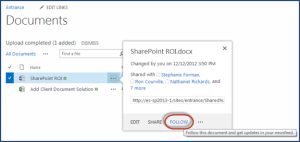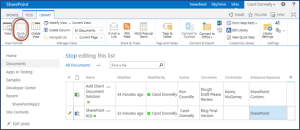Top 10 New Records Management Features in SharePoint 2013
It’s an awesome feeling when a brand you love makes positive strides and investments in the things you already love about their product. When it comes to SharePoint 2013, Microsoft has definitely been listening to our needs and expanding on what we love. There was so much information at Microsoft’s SharePoint Conference 2012, but for this blog I plan to focus on what we can expect from the platform in regards to record management.
When SharePoint 2010 was released we found ourselves with a host of new tools in our tool belt:
- Content Organizer
- Document Sets
- Document IDs
- Location Based Metadata
- In-Place Records Management
- Managed Metadata
- Metadata Navigation
As with rolling out any new feature sets some were amazing (Location Based Metadata), even if I’m not sure they caught on with everyone and others (Document IDs) left… well something to be desired.
So, you may be asking yourself what you can expect from 2013 in the record’s management department. Well, there’s not a ton of new stuff, but you can expect expanded functionality and improvements in the 2010 features you were excited about three years ago.
My Top 10 New features/enhancements in SharePoint 2013
- Drop and Drop content into Document Library’s
 Woo hoo! This one is going to be a great addition to your user adoption arsenal. It even works in browsers that are not Internet Explorer!
Woo hoo! This one is going to be a great addition to your user adoption arsenal. It even works in browsers that are not Internet Explorer!
2. Site Retention
Tired of having to manage your retention policies at the document or list level? Your wait is over; with 2013 Microsoft is introducing the ability to define policies directly at the site level! It allows you to define three things: the retention policy, what causes the project to close, and when a project should expire. A closed site disappears from your navigation and exchange and sits quietly waiting their expiration date. Expired sites are destroyed.
3. Site Mailboxes
Ah, Exchange and SharePoint integration, we’ve all wanted improvements here since 2007 and you can rejoice that Microsoft has finally listened and delivered a workable solution. Exchange mailboxes and SharePoint can now talk and it’s easy to add associated mailboxes for a site. This allows users to drag and drop email from outlook into the site’s mailbox for everyone to see or drag it into the document library for treatment as a record. Closing the site removes the exchange mailbox. It seems, all is well with the world
4. Cloud Parity
For those of you like me who have already dabbled in the first iteration of Microsoft Office 365, you can breathe a sigh of relief that the 2013 version will bring records management functionality previously omitted to the table. In Place Records, Record Centers and centralized repositories are all available in the new O365.
5. Social ECM
Seems everything is going social these days and SharePoint is no exception. Document management is now rolling up into news feeds and you can follow your favorite documents like you follow your favorite people on twitter. SharePoint will even suggest documents you should follow.
6. Managed Navigation
I wish I could insert the demo here for all to revel in the glory of this feature. Sincerely, this will help eliminate one of the MAJOR issues with building out site collections for all the teams who really need them within a portal. Farm administrators know the headache involved with trying to maintain navigation as soon as you go from 1 to 2 site collections, but a truly robust and properly planned solution SHOULD have more than one site collection. For an intranet solution, it’s usually at least one per department and truly most teams have the need for their own site collection based on different needs for features and policy sets. In the past we’ve had to implement custom navigation solutions in order to implement site structure correctly. This new feature will keep us from trying to implement complex subsite structures or writing custom code just, so it’s easy to manage our navigation as administrators.
7. Quick Edit View
Quick Edit view is replacing datasheet view and allows us to edit metadata on multiple files simultaneously much like it did in 2010, but with a cleaner looking interface. The real value add comes when working with managed metadata. As much as I was excited about managed metadata’s debut in 2010, it was a disappointment that it did not allow for editing in the datasheet view. It kept me from rolling it out in many instances because users like the ability to quickly edit items. Resolving this issue will allow me to embrace this feature like I’d previously hoped to.
8. Hover over document preview of search results
You mean I don’t have to buy FAST or a third party solution to have a thumbnail preview my documents in my search results? NOPE, close your pocket books and enjoy a much more robust and user friendly search experience.
9. Document Sets
You can now add One Note and Folders into Document Sets, improving flexibility. There’s also the ability to manage the entire document set by sending it to a record center.
10. eDiscovery Center
SharePoint 2010 went a long way to improve records discovery with the introduction of in place holds. 2013 takes it a step further with the introduction of the eDiscovery Center, where you can now manage preservations, search and export across site collections, SharePoint farms and even Exchange servers.
For more on record management in SharePoint, check out this other post. We also post tips and tricks related to SharePoint 2013 as we’ve run across them. Check them out here…




